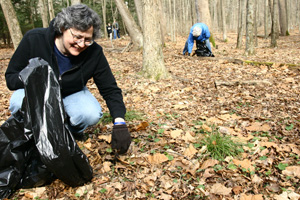Around Six Mile Creek, leafy green stalks with small white flowers gradually grow throughout the ground. The garlic mustard plant, native to Europe and Asia and now growing in Ithaca’s natural areas, threatens the native vegetation — and it has been for the past five years.

Zev Ross, chair of the city of Ithaca’s Natural Areas Commission (NAC), said the wildflower preserve in the Six Mile Creek area is known for its unique species, specifically the small flower Trillium. Garlic mustard and Trillium are both seasonal spring plants, which means they compete for resources.
“There [are] some pretty unique species that are threatened by garlic mustard, which proliferates so quickly that it crowds [them] out,” Ross said.
At the NAC’s first plant pull of the season Saturday — events that happen every spring — about 20 volunteers got down on their hands and knees to yank the plants out of the ground.
Anna Stalter, chair of NAC’s invasive species subcommittee, said the group picked about eight garbage bags full.
“It depends on the time of year, [so] the plants are really small now,” she said. “We probably picked more than in the past if you consider that.”
Garlic mustard was first introduced to the United States as a salad green because of its garlicky taste, said senior Jessica Langan-Peck, an intern with the NAC who has worked on the garlic mustard removal. Unfortunately, the plant is now growing in Ithaca’s natural areas and choking out indigenous plants. NAC has been combating the spread of the invasive species for the past five years.
Because the plant is not native to the Ithaca area, it has no natural competitors, which allows it to overtake local plant growth. The NAC is responsible for protecting Six Mile Creek, South West, Ithaca Falls and Fuertes Bird Sanctuary, the four natural areas in Ithaca. Garlic mustard is most abundant in the Six Mile Creek Natural Area.
Langan-Peck, a writing major with a minor in environmental studies, said once the garlic mustard plants start to grow, they take over everything in their area.
“It’s really hearty and really fast-growing, and it basically takes over the habitat of native stuff that’s growing there,” she said.
Langan-Peck said NAC is looking for grant money to help fund its work and has submitted a grant request from the Howland Community Foundation, a local foundation that gives grants to qualified non-profits in Tompkins County.
“We’re also looking into … some big state grants, the Department of Environmental Conservation and even on a national level [from] the National Fish and Wildlife [Foundation],” Langan-Peck said.
Stalter said garlic mustard is not the only invasive plant in the area but is the one NAC focuses on the most.
Garlic mustard is the easiest to identify, Stalter said, and is relatively easy to remove. Some of the other invasive plants, like honeysuckle and privet, are much harder to remove, so the NAC does not gear volunteer work toward their removal, she said.
Stalter said volunteers from Cornell University and the college participated in Saturday’s event, but the NAC would especially like to see more students from the college lend a hand.
“Six Mile Creek is right in the college’s backyard,” she said. “So if we can get Ithaca College students involved it would be great.”







